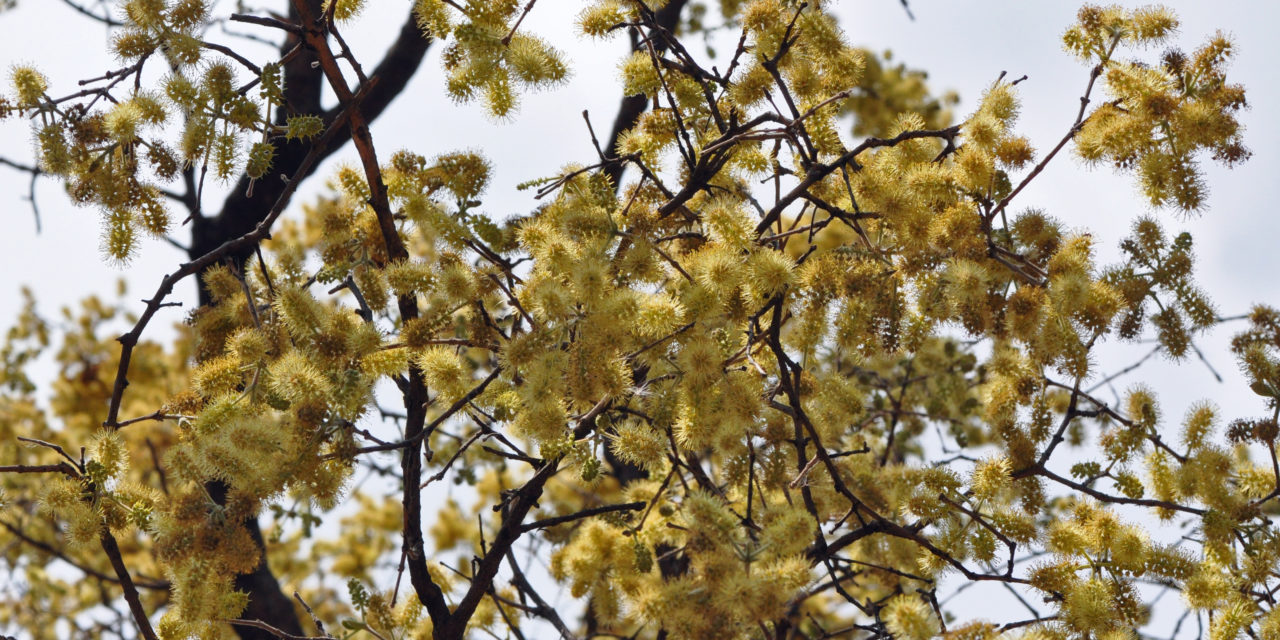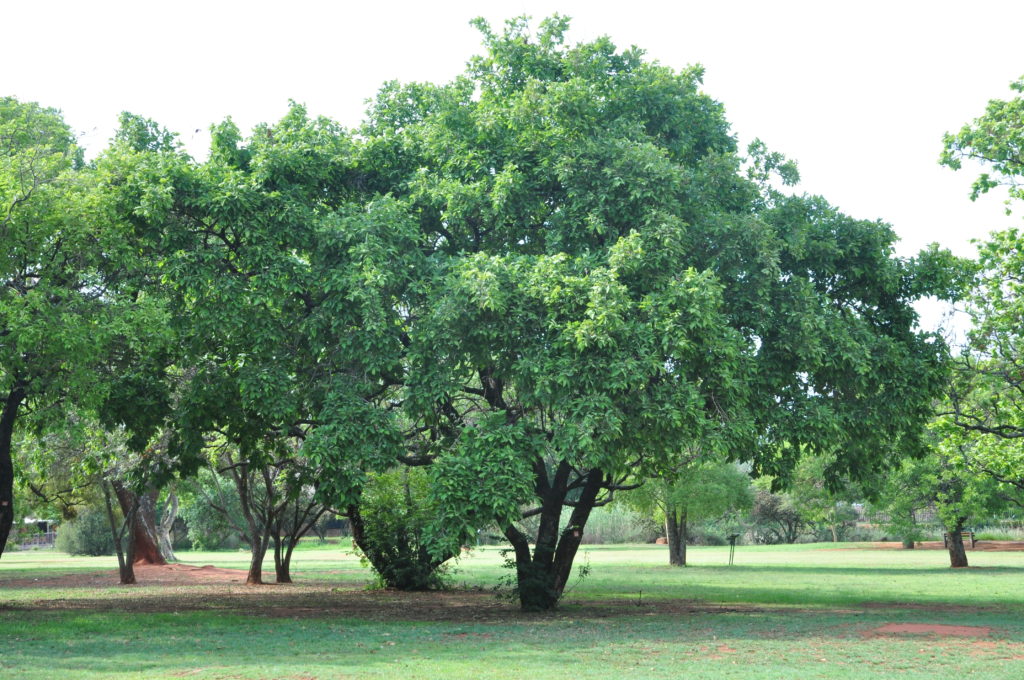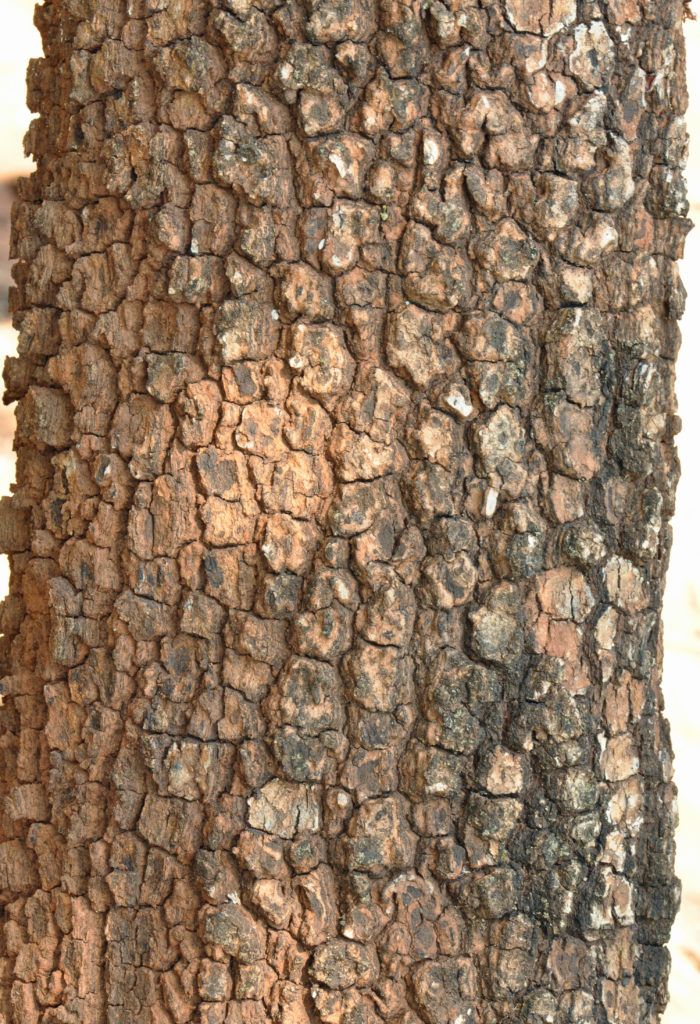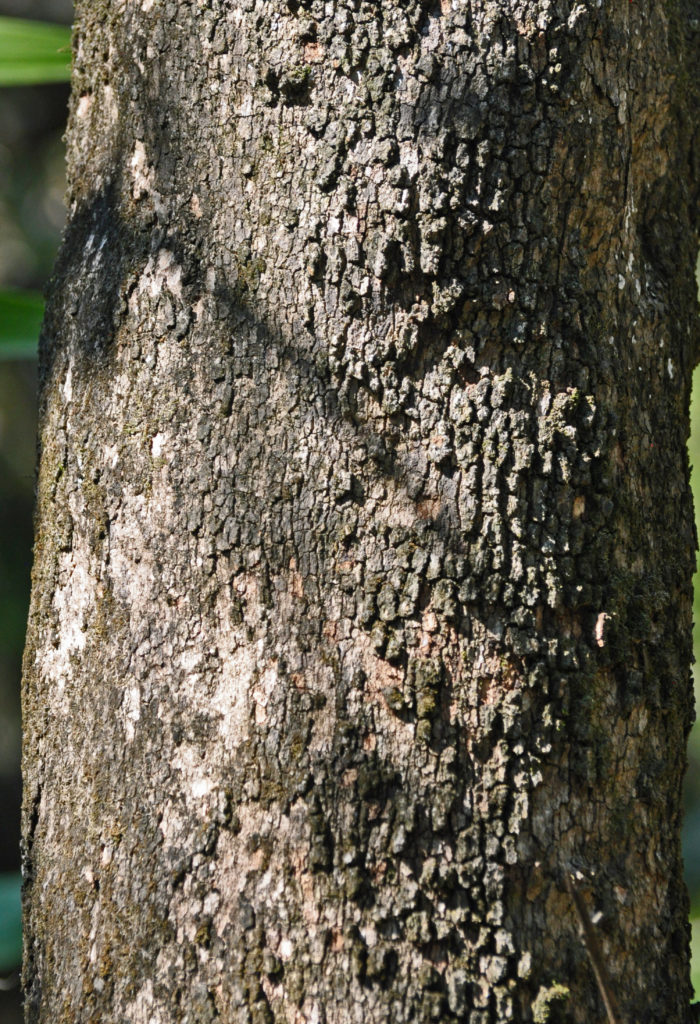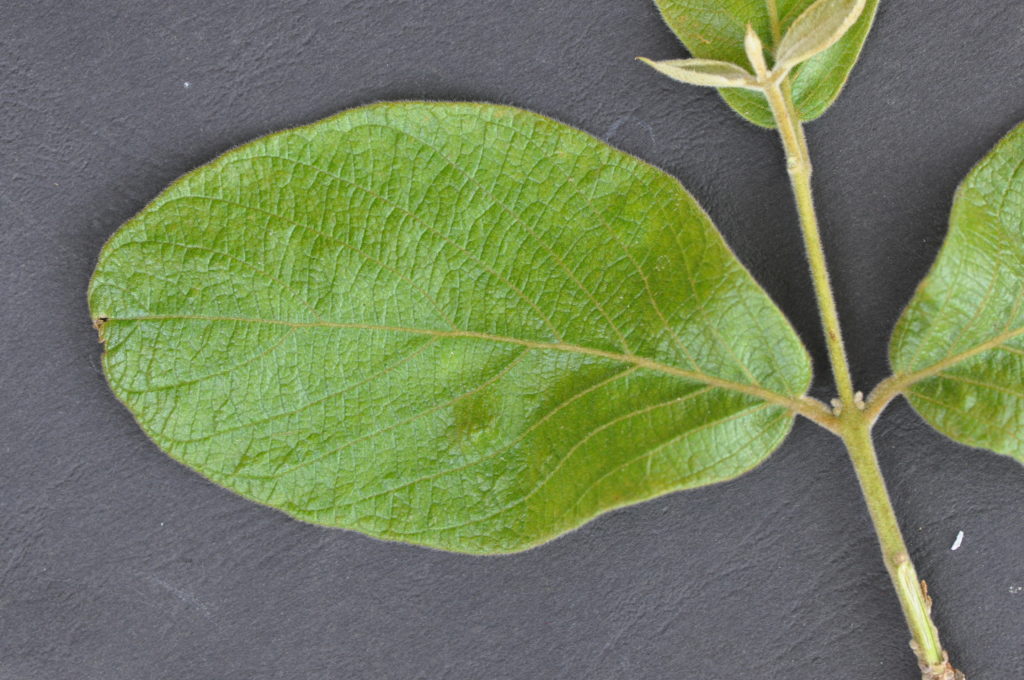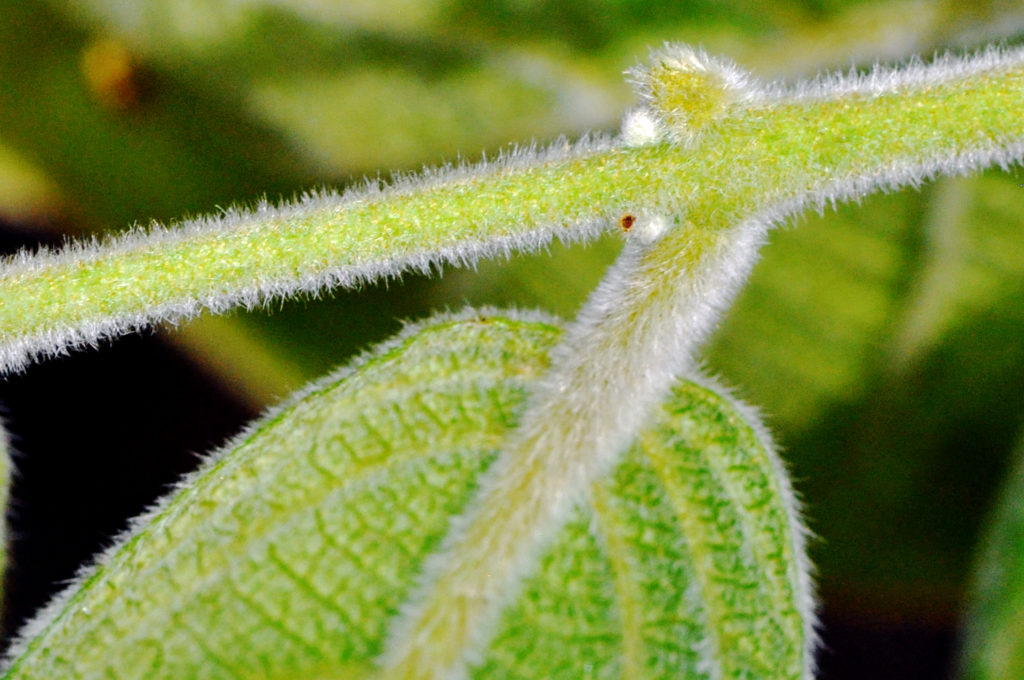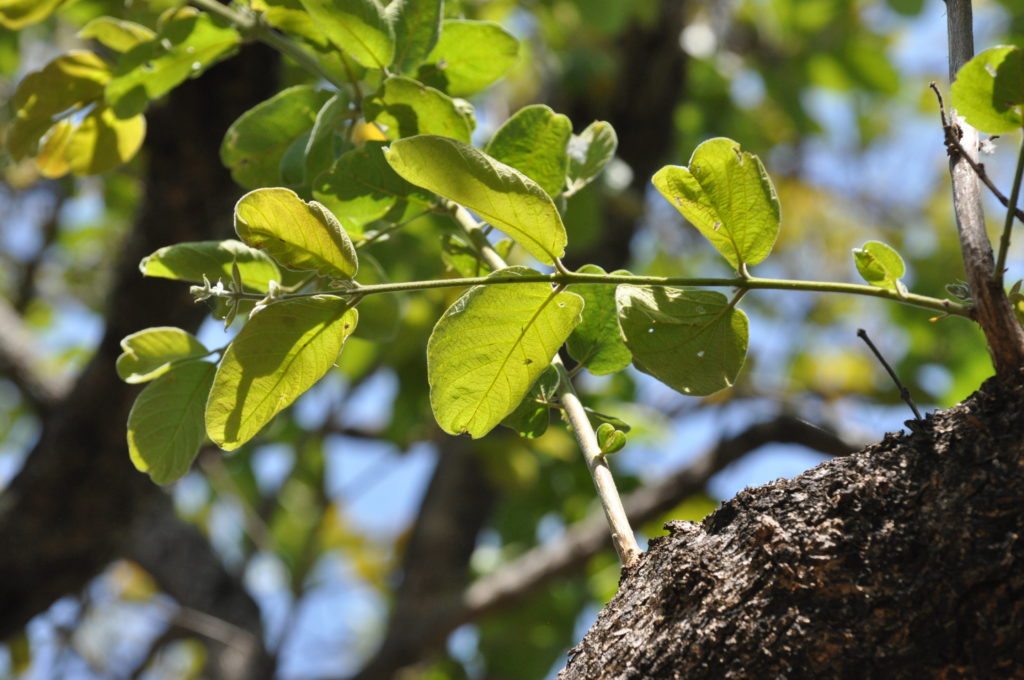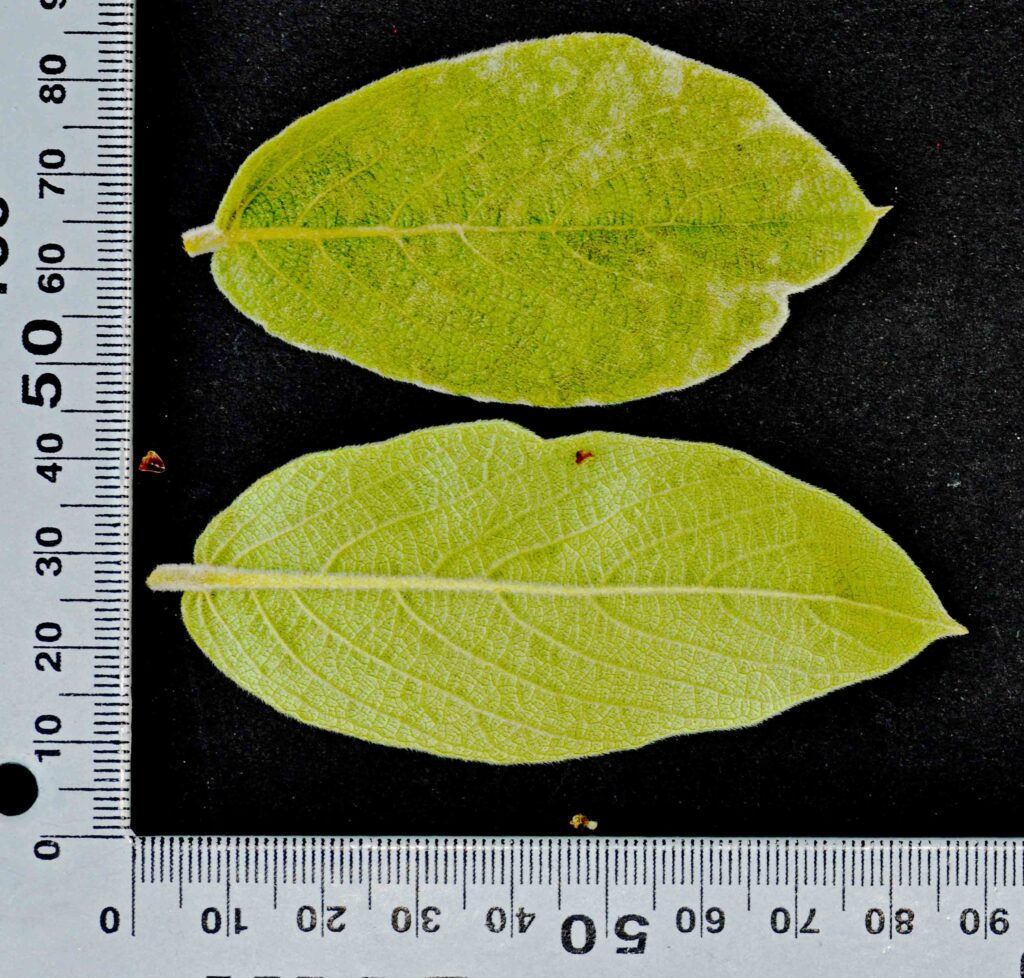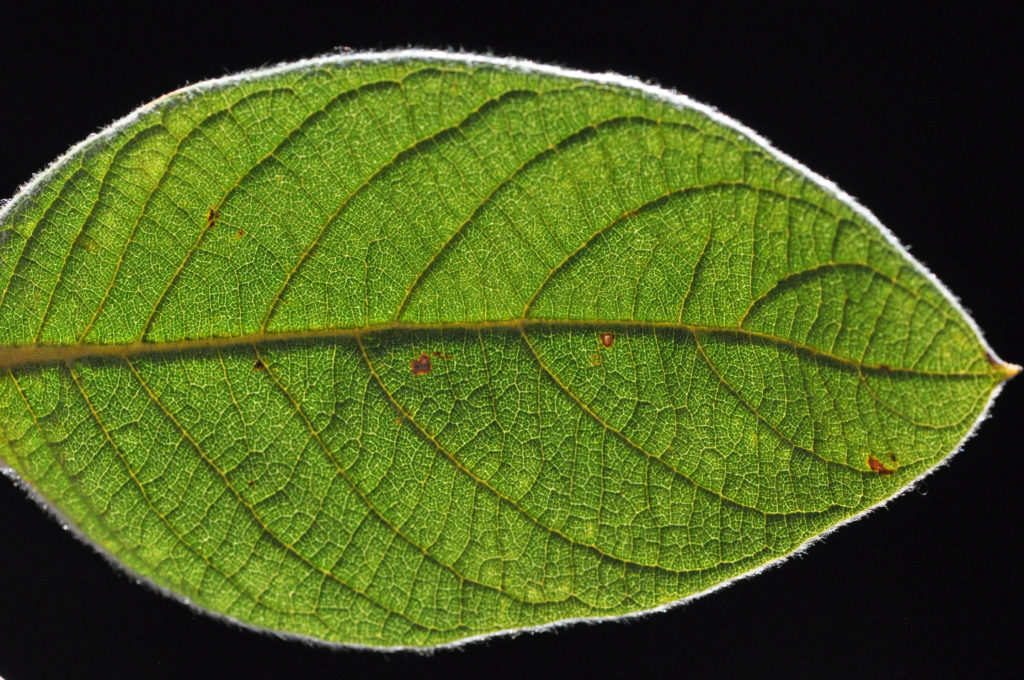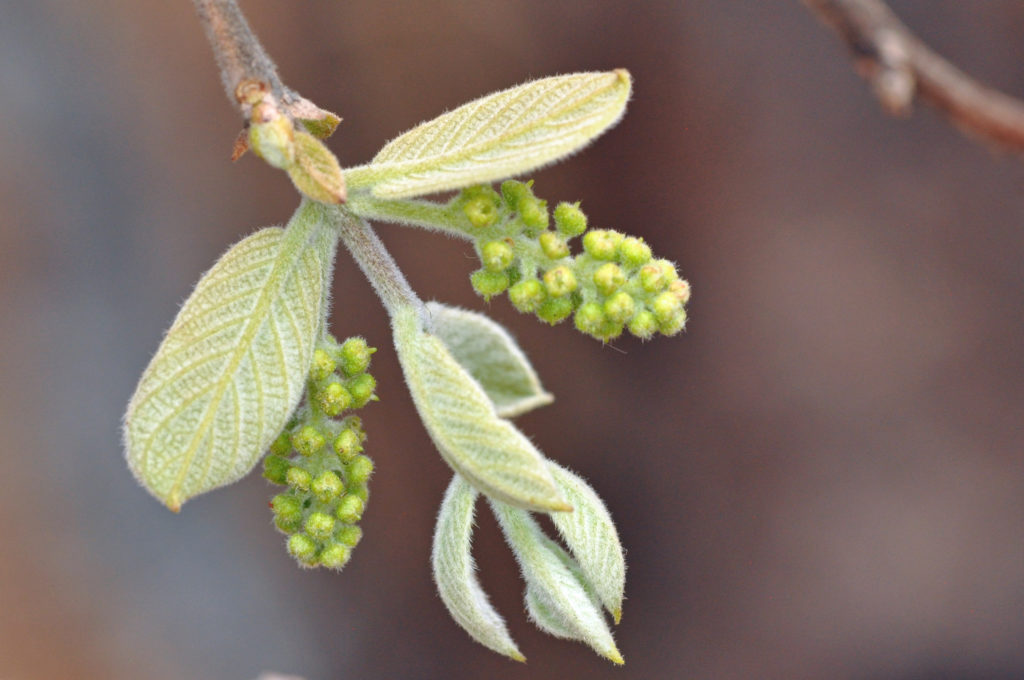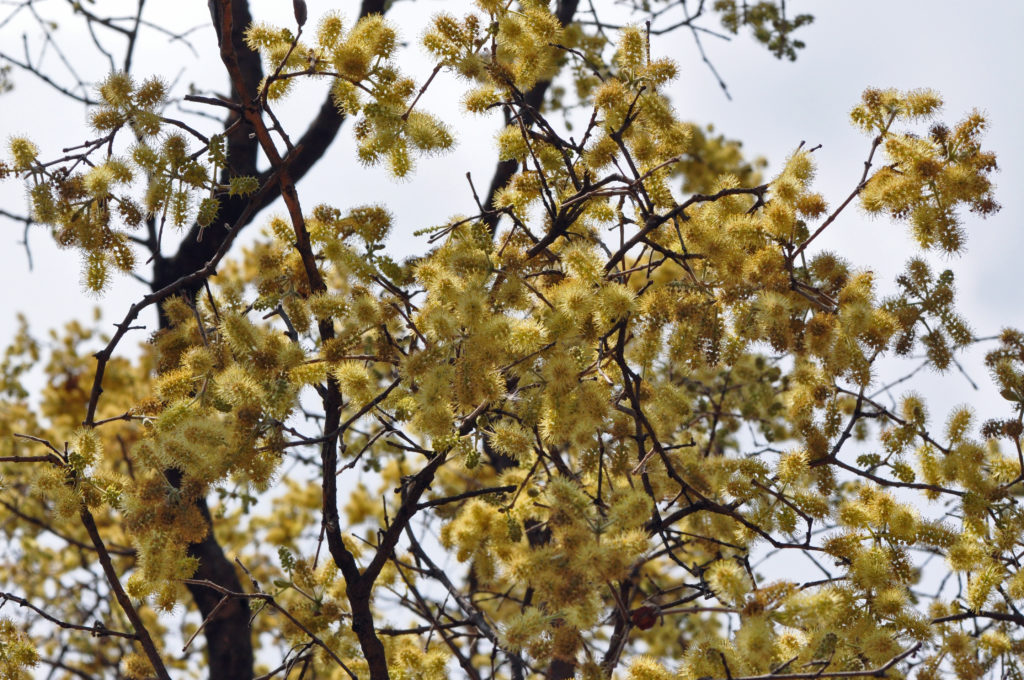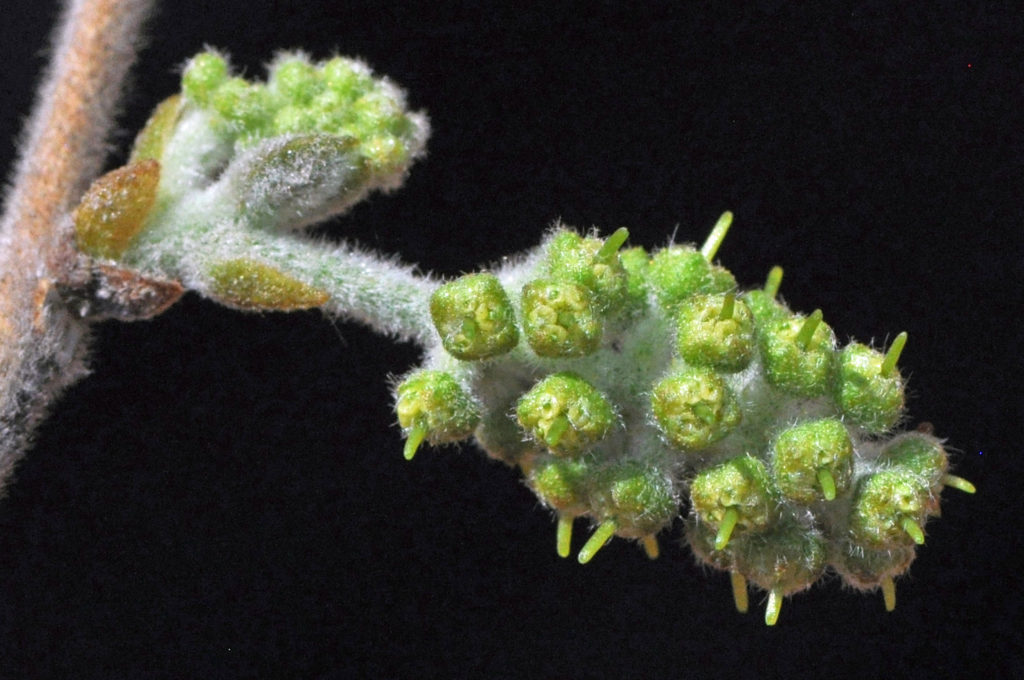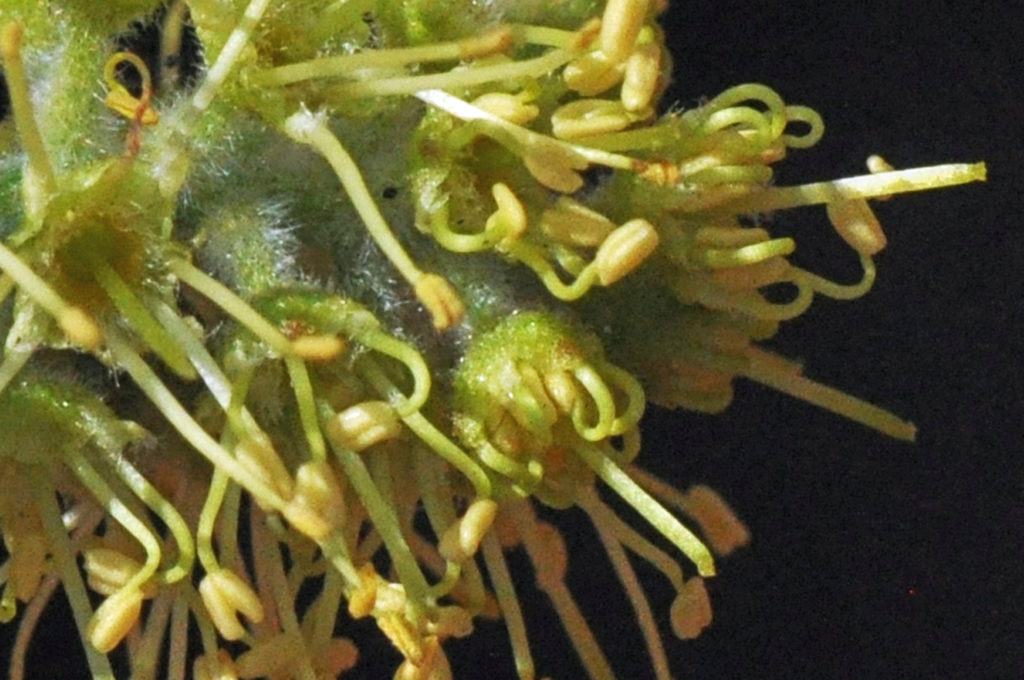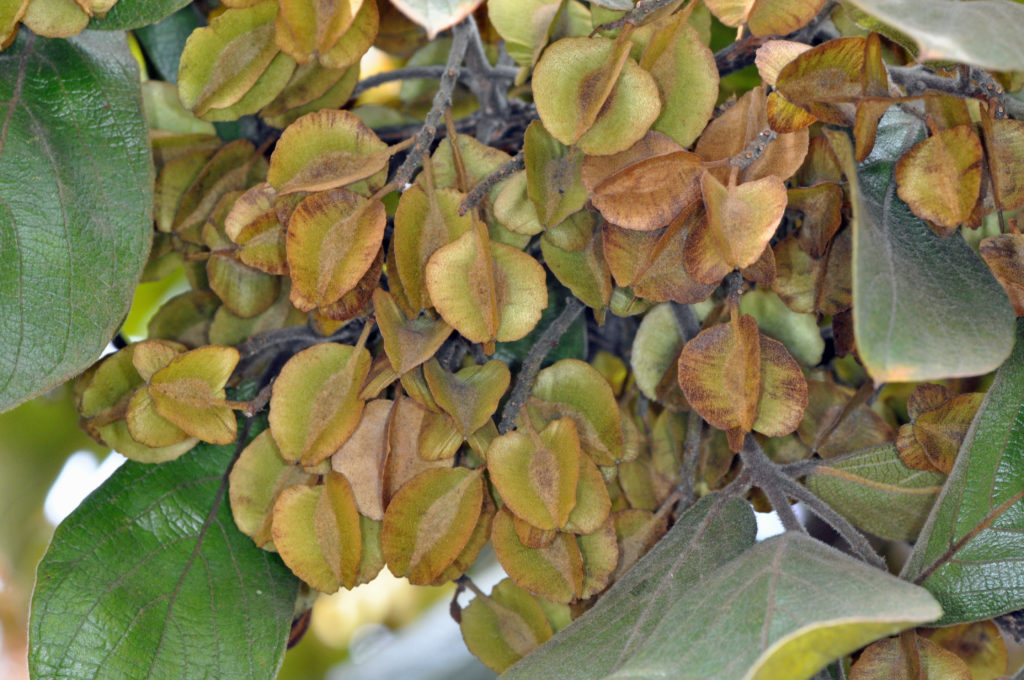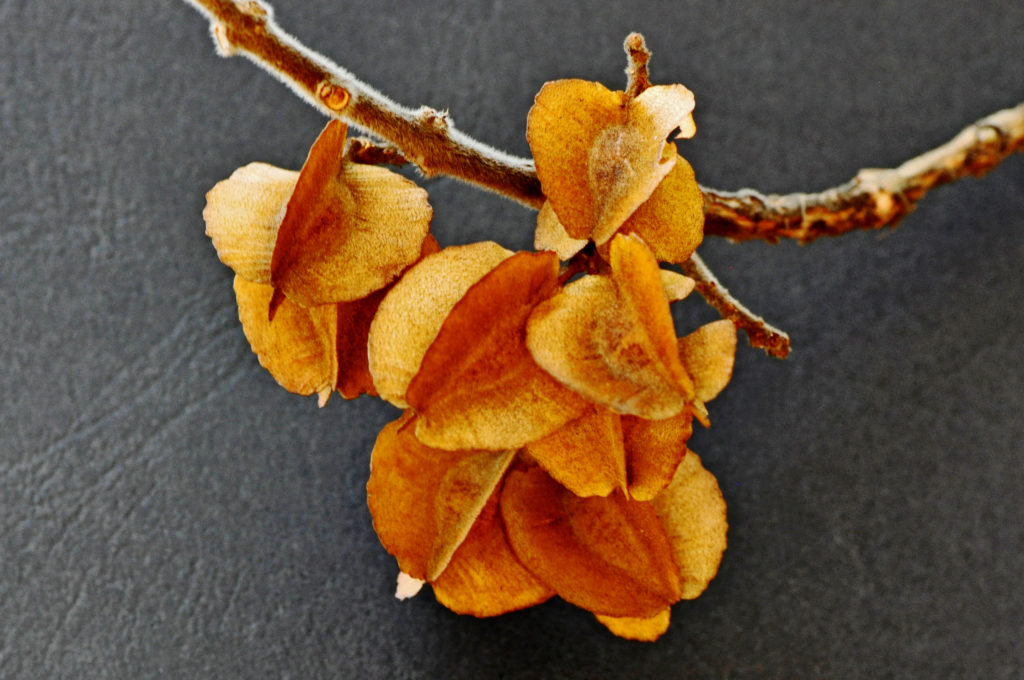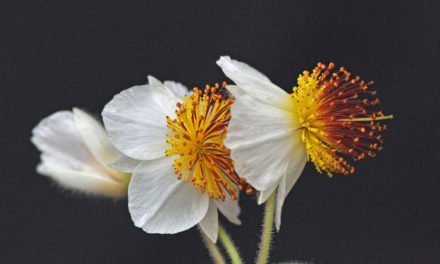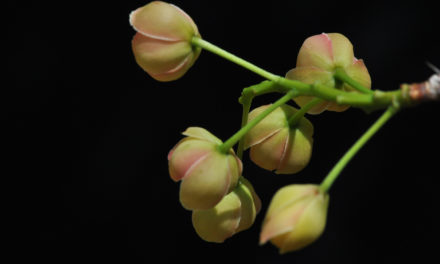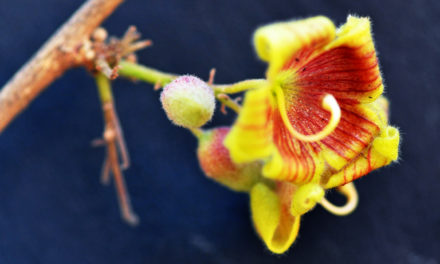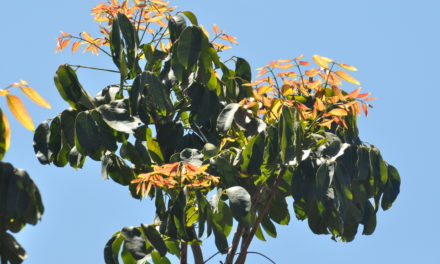General Info – summary
The tardily deciduous, gum yielding Tree has a rounded crown and is up to 12m high. The variously shaped, simple, velvety and opposite Leaves have entire margins and lack stipules. The up to 20 bisexual, regular Flowers in each spike are small, yellowish, with green sepals, small petals and 8 exerted stamens. The inferior ovary has an exserted style. The 4–winged, single seeded Fruit is an indehiscent samara.
Description
Previous Names: Combretum arengense, Combretum atelanthum, Combretum gueinzii, Combretum holosericeum, Combretum microlepidotum, Combretum pisoniiflorum.
SA Tree No. 537.
Common names: (Afr) Basterrooibos, Fluweelboswilg. (Eng) Velvet Bush willow, Velvet leaf willow, Velvet-leaved Combretum, Velvet leaf willow. (isiZulu) UmBondwe-omhlope. (Northern Sotho) Mokgwethe. (siSwati) Inkukutwane. (Tshivenda) Mugwiti. (Xitsonga) Moduba, Modubatshipi, Xikhukhutsane.
Family: Combretaceae (Bushwlillow family). In this family, there are about 16 genera, which contain about 530 species. In South Africa, there are 5 genera and 41 species. Genera with Trees on this website include Combretum, Lumnitzera, Pteleopsis and Terminalia. The simple and usually entire Leaves lack stipules. Flowers are usually bisexual. There are usually twice the number of stamens as sepals or petals. The inferior Ovary has 1 locule and usually only 1 of the ovules develops into a seed. Fruit is usually indehiscent and may be winged or ridged.
Name derivation: Combretum a climbing plant named by Pliny (AD 61-113). molle referring to the velvety (soft, smooth) texture of the leaves and/or the presence of soft hairs.
Conservation: National Status: L C. (Least Concern). Assessed: 2005 (W. Foden and L. Potter).
Tree
This gum yielding plant is usually not a shrub (photo 324) and the Tree may reach 12m high. The usually rounded Crown (photo 324) has high up drooping branches that tend to spread. Twigs (1-year-old current branch segments) are often hairy (Photo 678 – under Leaves). It has a Trunk that may reach a diameter of 40cm or more. The grey, smooth, young Bark turns brown or black and becomes rough and fissured into small brown blocks (photo 673). In well-established trees, the bark becomes dark brown to black and flakes into fibrous strips (photo 608). Branchlets have untidily exfoliating bark (exfoliate – shedding of the surface layers).
- 324. 2016/11/08. Pretoria NBG. Photo: David Becking.
- 673. 2014/10/30. Pretoria NBG. Photo: David Becking.
- 608. 2014/09/14. Lowveld NBG. Photo: David Becking.
Leaves
This velvet bush willow (here velvet refers to the soft feel of the leaves) may be evergreen, or deciduous – especially if there is insufficient water. The ornamental Leaves are simple (have a single blade, which may have incisions that are not deep enough to divide the blade into leaflets). They are opposite (photo 680 & 683) and size varies: (14) 7 x 4 (9)cm (photo 677). Leaves are variously shaped and may be narrowly to broadly elliptic, ovate or obovate to almost circular. Young leaves (photo 683) may be orange or light pink and autumn leaves may be tinged with red or purple. Mature leaves are medium to dark green, leathery, and occasionally hairless but usually hairy on both surfaces – especially when young and especially on the lower surface. Leaf Veins are conspicuously raised below. They are best observed against a strong light (photo 377). In this photo, the ladder-like smaller veins linking the side veins are visible as are the hairy Margins. Each margin is slightly rolled under and entire (with a continuous margin, not in any way indented). Up to 12 pairs of side-Veins are distinctly sunken and slightly darker above, but protrude and are prominent below (photo 677). The hairy margin is also visible in photo 678. The Apex tapers or is blunt or rounded (photo 683). It may be mucronate (having an abruptly projecting point – photo 677) and may end with a drip-tip. The Base is rounded, flat (photo 683) or lobed. The short, thickset (photo 677) and hairy Petiole (leaf stalk – photo 678) is up to 5mm long. Stipules (basal appendages of the petiole) are absent.
- 683. 2014/09/14. Lowveld NBG. Photo: David Becking.
- 678. 2014/10/30. Pretoria NBG. Photo: David Becking.
- 680. 2014/09/14. Lowveld NBG. Photo: David Becking.
- 677. 2014/10/30. Pretoria NBG. Photo: David Becking.
- 377. 2018/04/24. Nylsvley NR. Photo: David Becking.
Flowers
The individual very small, light yellow or greenish yellow, honey scented Flowers are in dense axillary Spikes (simple indeterminate inflorescence with sessile flowers on a single unbranched stalk – photo 74). The fruity spikes, which may eventually cover the tree (photo 152), usually appear before or with the new leaves and are up to 9cm long (photo 74). In photo 157, the hairy peduncle (stalk of flower cluster) is clearly visible. However, what appears to be a pedicle (stalk of a single flower), is in fact the inferior ovary that protrudes below. Each spike contains 20+ flowers that are bisexual and actinomorphic (Regular, symmetrical. Flowers are vertically divisible into similar halves by more than 1 plane passing through the axis). The calyx has 4 green Sepals (photo 154) and the Corolla has minute or absent Petals. The 8 Stamens (male reproductive part of a flower. They produce pollen in the terminal Anthers, which are usually supported by the Filaments). In this plant the filaments uncurl as they emerge to surround the base of the already extended Styles (photo 154). The dorsifixed (attached by or at the back – dorsal side) Anthers are versatile (hung or attached near the middle, and usually moving freely – photo 154). There is a single Pistil (a unit of the Gynoecium, the female element of the flower, composed of the Ovary, Style and apical Stigma – photo 154). The inferior Ovary has 1 locule in which only 1 Ovule develops. The ovary extends into a single free long Style (photo 154). The Stigma and Style emerge from the bud before the stamens (photo 157). In this photo, the unopened and curled up anthers are just visible. (Aug-Nov). Round Galls are often present. (Sep-Nov).
- 74. 2016/10/18. Pretoria NBG. Photo: David Becking.
- 152. 2017/09/19. Pretoria NBG. Photo: David Becking.
- 157. 2017/09/19. Pretoria NBG. Photo: David Becking.
- 154. 2017/09/19. Pretoria NBG. Photo: David Becking.
Fruit
The relatively small – usually up to 2 x 1,7cm, indehiscent Fruit is 4-winged Samara (a dry, indehiscent winged fruit. The 4 Wings are papery and develop from the ovary wall). Each samara is usually hairy and small – roughly 2 x 1,5cm. This fruit changes from light green (photo 624) to grey-brown and finally to an impressive golden red/brown when dry (photo 676). The mature fruit may remain on the tree for months – even after the new flowers appear. (Dec-Aug+).
- 624. 2016/08/23. Pretoria NBG. Photo: David Becking.
- 676. 2014/10/30. Pretoria NBG. Photo: David Becking.
Distribution & Ecology
This Plant is not endemic to South Africa. These plants occur up to an altitude of about 1 600m in summer rainfall areas. These areas include forest margins, open woodlands, savannah (a rolling grassland scattered with shrubs and isolated trees, which can be found between a tropical rainforest and desert biome) and bushveld (a sub-tropical woodland ecoregion of southern Africa). They are also located in sheltered rocky places, on hills and ridges and in sourveld (veld that is largely covered with coarse seasonal perennial grasses and affords inferior grazing). These areas include Magaliesberg, Waterberg and the Soutpansberg mountains. Trees are often associated with quartzite (a hard, metamorphic rock that is not foliated) formations. The South African Provinces include KwaZulu-Natal e.g., Kosi Bay, Free State, Gauteng e.g., Pretoria and Johannesburg, Mpumalanga, Limpopo and North West. High demand for timber (for building, carving and charcoal manufacture may become a problem that needs to be monitored. The trees also occur in Eswatini (Swaziland), Mozambique (widespread), Angola, Botswana, Zimbabwe, northern Namibia and northwards to the Arabian Peninsula – including Yemen. This plant often grows with Combretum zeyheri, Burkea africana and Vachellia (Acacia) robusta. Trees respond to coppicing (when stems are cut or burned it causes regrowth from the stump or roots). For best regrowth results, harvesting should be carried out about 1m above the ground to promote new growth. Leaves and young shoots are browsed by antelope e.g., Kudu. The heavily scented Flowers attract insects – including bees that are involved in pollination. The leaves are the larval food for a number of butterflies – including the fast, low flying and continuously breeding Guineafowl butterfly (Hamanumida daedalus) which has a dark grey upper side with guineafowl-like white spots on its wings. Their larvae also feed on the leaves of Terminalia sericea). The adults are on the wing during winter and early spring as well as from summer to autumn. They are common in forest edges and hilltops). The Morants Orange butterfly (Parosmodes morantii) has larvae that feed on the leaves. The leaves are also larval food for the widespread African moth Thyas rubricata. Another moth, Acalyptris molleivora has larvae that feed on Combretum molle.
Ethnobotany
This attractive tree with its long lasting fruit and even as a shade tree, will do well in in a dry winter and summer rainfall garden. Rather clear, reasonable quality edible Gum occurs on the tree. A red dye is extractable from the Leaves and a yellow-brown dye from the Roots. These are used in processing local fabrics. The yellowish-brown Wood is reasonably hard, dense, and termite resistant. Uses of the wood include grain-stamping mortars, hut building, implement handles, household utensils and fence posts. It is also a useful fuel, including an excellent charcoal. The trees are severe frost sensitive. The relatively fast-growing Seeds germinate easily and the cotyledons (seed leaf; primary leaf or leaves in the embryo appear above the ground. Bark extracts have some antibacterial and antifungal activities. The tree contains antioxidants and saponins (glycoside, which foams when added to water. This aids in reducing ammonia levels in animal urine and thus help prevent respiratory tract problems.). These saponins occur in beverages and cosmetics as emulsifiers or sweeteners. This Plant is widely used in local medicine, including for wound dressing. New plants may be generated from fresh seeds and cuttings. These plants respond well to coppicing (when stems are cut or burned it causes regrowth from the stump or roots).
References
Boon, R. 2010. Pooley’s Trees of eastern South Africa. Flora and Fauna Publications Trust, Durban.
Burrows, J.E., Burrows, S.M., Lotter, M.C. & Schmidt, E. 2018. Trees and Shrubs Mozambique. Publishing Print Matters (Pty) Ltd. Noordhoek, Cape Town.
Coates Palgrave, M. 2002. Keith Coates Palgrave Trees of Southern Africa, edn 3. Struik, Cape Town.
Foden, W. & Potter, L. 2005. Combretum molle R.Br. ex G.Don. National Assessment: Red List of South African Plants version . Accessed on 2024/09/10.
Lawrence, G. H. M, 1951. Taxonomy of Vascular Plants. The Macmillan Company, New York. Tenth Printing 1965.
Palmer, E. & Pitman, N. 1972. Trees of southern Africa. Balkema, Amsterdam, Cape Town.
Schmidt, S. Lotter, M. & McCleland, W. 2002. Trees and Shrubs of Mpumalanga and the Kruger National Park. Jacana, Johannesburg.
van Wyk, B. & van Wyk, P. 1997 Field guide to Trees of Southern Africa, Struik, Cape Town.
Woodhall, S. 2020. Field Guide to Butterflies of South Africa, edn 2. Donnelley, RR, China.
http://www.plantzafrica.com/plantcd/voteplant.php
https://en.wikipedia.org/wiki/Combretum_molle
http://www.zimbabweflora.co.zw/speciesdata/species.php?species_id=141970
http://posa.sanbi.org/flora/browse.php?src=SP

